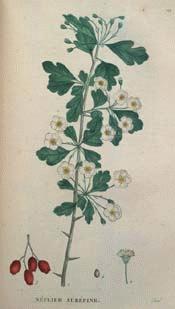
Botanical.com Home Page

|
Smooth Hawthorn
(Crataegus laevigata Poir.)
Click on graphic for larger image
|
Hawthorn
Botanical: Crataegus oxyacantha (LINN.)
Family: N.O. Rosaceae
---Synonyms---May. Mayblossom. Quick. Thorn. Whitethorn. Haw. Hazels. Gazels. Halves. Hagthorn. Ladies' Meat. Bread and Cheese Tree.
(French) L'épine noble
(German) Hagedorn
---Part Used---Dried haws or fruits.
---Habitat---Europe, North Africa, Western Asia.
---Description---The Hawthorn is the badge of the Ogilvies and gets one of its commonest popular names from blooming in May. Many country villagers believe that Hawthorn flowers still bear the smell of the Great Plague of London. The tree was formerly regarded as sacred, probably from a tradition that it furnished the Crown of Thorns. The device of a Hawthorn bush was chosen by Henry VII because a small crown from the helmet of Richard III was discovered hanging on it after the battle of Bosworth, hence the saying, 'Cleve to thy Crown though it hangs on a bush.' The Hawthorn is called Crataegus Oxyacantha from the Greek kratos, meaning hardness (of the wood), oxcus (sharp), and akantha (a thorn). The German name of Hagedorn, meaning Hedgethorn, shows that from a very early period the Germans divided their land into plots by hedges; the word haw is also an old word for hedge. The name Whitethorn arises from the whiteness of its bark and Quickset from its growing as a quick or living hedge, in contrast to a paling of dead wood.
This familiar tree will attain a height of 30 feet and lives to a great age. It possesses a single seed-vessel to each blossom producing a separate fruit, which when ripe is a brilliant red and this is in miniature a stony apple. In some districts these mealy red fruits are called Pixie Pears, Cuckoo's Beads and Chucky Cheese. The flowers are mostly fertilized by carrion insects, the suggestion of decomposition in the perfume attracts those insects that lay their eggs and hatch out their larvae in decaying animal matter.
[Top]
---Constituents---In common with other members of the Prunus and Pyrus groups of theorder Rosaceae, the Hawthorn contains Amyddalin. The bark contains the alkaloid Crataegin, isolated in greyish-white crystals, bitter in taste, soluble in water, with difficulty in alcohol and not at all in ether.
---Medicinal Action and Uses---Cardiac, diuretic, astringent, tonic. Mainly used as a cardiac tonic in organic and functional heart troubles. Both flowers and berries are astringent and useful in decoction to cure sore throats. A useful diuretic in dropsy and kidney troubles.
---Preparation and dosage---Fluid Extract of Berries, 10 to 15 drops.
The leaves have been used as an adulterant for tea. An excellent liquer is made from Hawthorn berries with brandy.
Formerly the timber, when of sufficient size, was used for making small articles. The root-wood was also used for making boxes and combs; the wood has a fine grain and takes a beautiful polish. It makes excellent fuel, making the hottest wood-fire known and used to be considered more desirable than Oak for oven-heating. Charcoal made from it has been said to melt pig-iron without the aid of a blast.
The stock is employed not only for grafting varieties of its own species, but also for several of the garden fruits closely allied to it, such as the medlar and pear.
---Other Species---
C. Aronia is a bushy species giving larger fleshy fruit than C. Oxyacantha. It is indigenous to Southern Europe and Western Asia and is common about Jerusalem and the Mount of Olives, where its fruit is used for preserves.
C. odoratissima is very agreeable also as a fruit.
C. Azarole. Its fruit in the same way is highly esteemed in Southern Europe.
Common Name Index
A MODERN HERBAL Home Page
Bear in mind "A Modern Herbal" was written with the conventional wisdom of the early 1900's. This should be taken into account as some of the information may now be considered inaccurate, or not in accordance with modern medicine.
© Copyright Protected 1995-2025 Botanical.com
|

